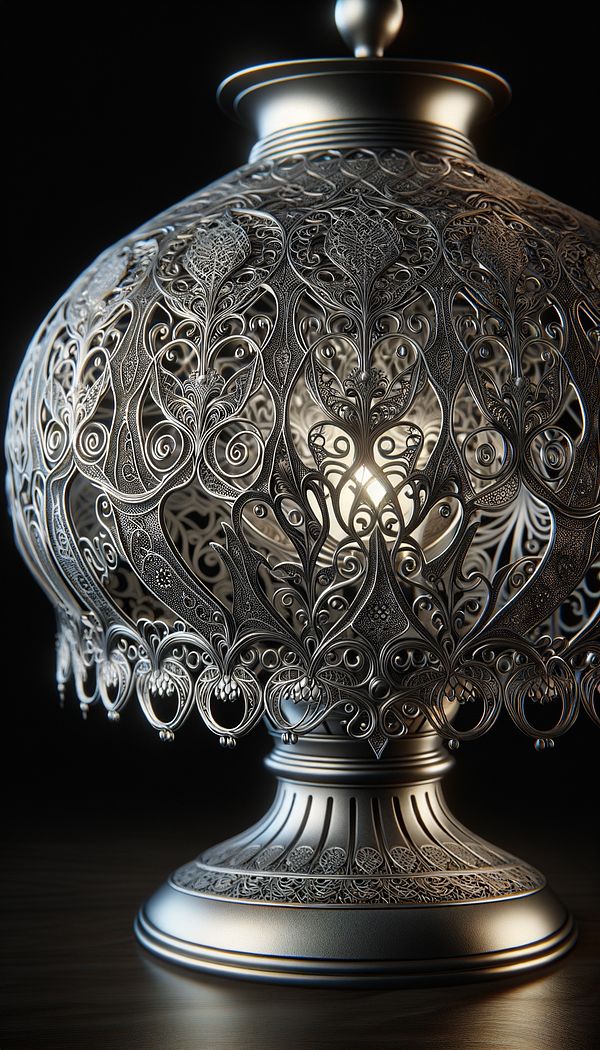What is Filigree?
Filigree refers to delicate and intricate ornamental work made from fine twisted wires, usually of gold or silver, used in jewelry, metalwork, and interior design elements.
Description
Filigree is an ancient technique that has been used for thousands of years to add a touch of elegance and refinement to various objects. In the context of interior design, filigree can be found in furniture, lighting fixtures, decorative objects, and architectural elements. It involves creating detailed patterns and motifs by twisting and soldering thin wires of metal, often gold or silver, but can also be done with other metals like copper or bronze.
Incorporating filigree into an interior space can bring a sense of luxury and meticulous craftsmanship to the environment. When used on furniture, it can be seen in the delicate inlay work on table tops, cabinet doors, or chair backs. In lighting fixtures, filigree patterns can add an ethereal quality to lamps and chandeliers, creating interesting shadows and light play in a room. Decorative objects like mirrors, wall art, and vases often feature filigree details that catch the eye and add depth to the decor.
Filigree, though ornate, can be versatile. It suits various design styles, from the opulence of Baroque and Rococo to the refined simplicity of Art Nouveau and even contemporary minimalism, where it’s used sparingly for a touch of adornment. The key to incorporating filigree successfully into a design scheme is to balance it with the surrounding elements to avoid overwhelming the space.
Usage
Filigree is most commonly seen in the design of luxury homes or high-end establishments, where attention to detail and an air of sophistication are desired. Architects and interior designers may opt for filigree patterns in door and window frames, in the metalwork of staircases, or in the detailing of furniture and light fixtures to create focal points in the space. In addition to its aesthetic appeal, filigree can also serve a functional purpose, like providing ventilation in delicately carved screens or panels.
FAQs
-
Is filigree exclusively used in traditional designs?
No, filigree isn’t exclusive to traditional designs. While it’s often associated with historical and classical aesthetics, filigree can be incorporated into modern and contemporary spaces as a decorative element that adds uniqueness and sophistication.
-
Can filigree be made with materials other than metal?
Traditionally, filigree is crafted from metal wires, especially gold and silver. However, the concept of intricate, lace-like patterns has inspired designs in other materials like wood, plastic, and even 3D printed objects, though these wouldn’t be considered true filigree in the traditional sense.
-
How does one care for filigree decorative items in a home?
Filigree items require careful handling due to their delicate nature. For metal filigree, regular dusting with a soft brush and cleaning with a mild soap and water solution, followed by thorough drying, is recommended. Avoid using harsh chemicals or abrasives that can damage the intricate work.
Practical Application
Incorporating filigree into your home decor can elevate the space with a sense of luxury and sophistication. Use it as an accent by selecting pieces like a filigree-framed mirror, lamp base, or wall art. Balance is key; too much filigree might overwhelm the space, while a few carefully chosen pieces can serve as stunning focal points that draw the eye and contribute to the overall aesthetic of the room. Consider the color and material of the filigree to ensure it complements the room’s color palette and design style.
-
Design Styles478 articles
-
Furniture Types599 articles
-
Lighting111 articles
-
Decorative Techniques322 articles
-
Decorative Objects240 articles
-
LineLine in interior design refers to the continuous mark or edge that defines shapes and forms, and guides the eye movement within a space.
-
Dowry ChestA dowry chest is a large, ornate storage chest.
-
Eight-Way Hand TiedEight-Way Hand Tied is a traditional method of sofa and chair construction known for its durability and comfort.
-
CoverletA coverlet is a lightweight, decorative bedspread.
-
PilasterA pilaster is a rectangular column that projects partially from the wall to which it is attached.
